|
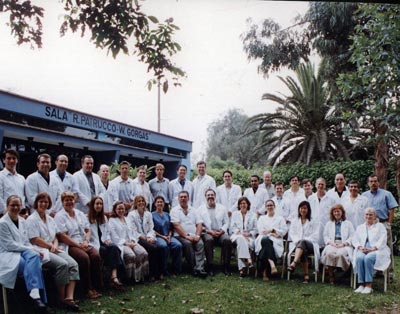
Gorgas group of students, 2005
|
In early 2005, I was a twenty-seven-year-old medical doctor working at the Mater Misericordiae Hospital in Dublin. I was spending a year in the Department of Medicine as a clinical tutor, with my responsibilities divided between ward duties and undergraduate training of medical students. Just over three years previously, I had graduated from the medical school of Trinity College, Dublin. My General Professional Training certification was complete and I had decided to pursue a career in the field of infectious diseases.
Approximately
twelve months earlier, I had been accepted into a world-renowned
tropical medicine course, called the ‘Gorgas course’,
in Peru for February to March 2005. (2)
The course represented a partnership between the Universidad
Peruana Cayetano Heredia, a Peruvian medical university
based in Lima, and the University of Alabama, a US American
medical school. One of my reasons for accepting the job
at the Mater Hospital was the fact that flexibility was
to be allowed, permitting me to combine study and holiday
leave to facilitate the required ten weeks of time in
South America. I am very grateful for the fact that this
was made possible by my employers and colleagues.
My reason for choosing a life of training in infectious diseases was mirrored in my reasons for picking the Gorgas course. First, it was undoubtedly going to be interesting. Secondly, it would be incredibly useful, with the course priding itself on a world-class combination of practical techniques, ward visits and didactic lectures. Thirdly, I could satisfy my continued yearning for travel and experiencing of new cultures. A tropical medicine course actually based in the tropics seemed like the perfect answer.
It would be a lie to purport purely altruistic motives for the trip. I knew that I would be there in a capacity as a student rather than as a doctor. I knew it would certainly be a learning venture, but in more ways than just the academic. I appreciated that every visit to a so-called ‘developing country’ influences the visitor, often for the better. Relative values of things are brought into perspective when you see problems caused by extremes of poverty and lack of resources. I hoped that I might benefit in a way that would help me and others in future times; in both the training I received and the outlook towards people in life and work.
We were to be thirty students representing all continents (barring the southernmost, coldest one, Antarctica, where tropical medicine is not at the forefront). The organisers had employed a commendable rule to ensure diversity. They knew that with such a high-quality syllabus and faculty they would not have any problem with filling the spots. However, without a ‘failsafe’ they would find themselves oversubscribed with North American students: that is where they are best known, and many United States and Canadian training programmes allow for time out for such courses. They decreed that no more than one third from one country be allowed and no more than one half from one continent.
They also had a travel scholarship open to two students from the developing world, ensuring that there would also be training for those who may be in a position to best employ it. Without the scholarship, the course fees were covered personally by individual students or through funding made available from training grants or similar sources.
I really did not know what to expect before leaving. I had been to India for a two-month work experience during a previous summer as a medical student, but felt that this would be an altogether different experience. And I was right. South America was one large stereotype in my mind. I had images of charismatic, beautiful people bursting out of overcrowded cities or sparsely dotting vast areas of country with intermittent flares of violence and passion. Preconceptions like this are difficult to justify in retrospect, and I am glad to have had the opportunity to dispel this simplistic vision.
|
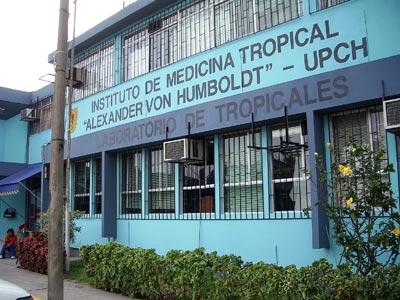
Hospital where the Gorgas course was held
(Arthur Jackson, 2005)
|
I landed in late January in Lima airport and was met by a senior doctor from the Department of Tropical Medicine - one of the most sincere gentlemen I have ever met. I was deposited at the appointed hotel in Miraflores, an upmarket area of Lima, where many embassies are located. This was the meeting point for all the students, where we were given our orientation. Here we were to make discerning first impressions of one another over the space of a few hours. After breakfast on the first day, we were to pair up or get a group together to find shared accommodation. A property consultant whisked us away in a minibus to find apartments. I was very lucky in finding three excellent roommates - an Australian, a Canadian, and an American. We were also delighted to find one of the best apartments available. Our new home was on the thirteenth floor of a new apartment complex that had wonderful views over Lima and the Pacific for prices that did not even come close to those of bleak suburban Dublin.
The course started on the Monday and immediately lived up to its high acclaim. Right from the start it was intensive but well organised, with quality lecturing and teaching. Our bus collected us at 7.15 a.m. from Miraflores with the academic day starting at 8 a.m. We began with two hours of lectures, followed by at least two hours of clinical rounds and bedside teaching. After lunch, there were two hours of practical laboratory sessions and after that, one to two hours of lectures. It was certainly much more intensive than undergraduate studies, with enthusiasm from students and lecturers at a much higher level.
The hospital was a tertiary referral tropical medicine centre for the whole of Peru. This means that they accepted cases from all over the country when local facilities were inadequate, or expertise unavailable. By European standards our hospital was poorly resourced, but they were still a superb unit with excellent clinicians and reasonable facilities on hand. They had four hundred beds, with no obvious priority given to the wealthy or privileged few.
Unfortunately many cases had diagnoses with expensive treatments but without the money to pay for them - the patients had to cover their own cost of treatment and often times this was unaffordable, with the result that the best treatments could not be given. At times even simple antibiotics were beyond their means. There was a ‘slush fund’ to pay for treatment in exceptional cases, but this could not be used universally.
The cases were of an incredibly vast array. There were the stereotypical tropical cases of malaria, typhoid fever, tuberculosis, and the like, and then there were the rarer cases. Looking back on my notes, I see that in our first three days we saw cases of leprosy, bartonellosis (a potentially fatal bacterial disease), lobomycosis (a chronic fungal infection), free-living amoebic encephalitis (an incredibly rare, almost invariably fatal brain infection) and even cases that remained a mystery to the best physicians in the field.
We covered many diseases that have worldwide distribution, not limited to tropical areas. These included tuberculosis and HIV/AIDS. Other conditions such as leischmania, bartonella and HTLV-1 were more specific, but not confined to Peru. I was surprised that HIV was not as prevalent as I had expected - it was very common by comparison with Ireland, but certainly not at the levels of the worst hit areas in the world. It was also very interesting to see the management of HIV, in particular in a resource-limited environment. I was used to a system that had very few constraints on clinical decision-making in terms of utilisation of resources. Once again, much of the burden of the cost of the medical care falls back to the patient. Peru was part of the concerted effort by the World Health Organization (WHO) to deliver free antiviral medication for HIV/AIDS to three million people in the developing world by 2005, but as in most places, the WHO was behind targets.
It was also frightening to see the extent of the problem of tuberculosis. This is a global phenomenon, and not particularly related to Peru. One manifestation was the emergence of a highly resistant form of tuberculosis called Multi-Drug Resistant TB, MDR tuberculosis. MDR tuberculosis is extremely difficult to treat, and consumes more and more patient lives and hospital resources. It has a tendency to arise in places where there is partial service provision for tuberculosis, which falls short of optimal standards: regimens that may not be completely effective, or services without facilities to ensure patient completion to the end of their many months of treatments. Financial and political shortcomings are usually to blame, and unfortunately there was evidence of both when one of the tuberculosis centres we visited announced that it would be shutting down. They were offering Directly Observed Therapy (DOT), which is the required measure to reduce MDR tuberculosis, but only had funding until the following year. Most health economic assessments see a clear benefit in tackling this problem, but preventative medicine measures are rarely used as a political tool due to the lack of hard results to show the populace.
For the most part our lecturers were excellent. Some were world experts in their field who were flown in for a series of lectures on their topic. They also told us about their overseas work and research, inspiring us as to how we ourselves could make our own contributions in the field.
The method of clinical teaching was also excellent. It was in the traditional style of bedside teaching in groups, and then methodically going through radiology and laboratory results. If applicable, we would then go to the pathology laboratory to retrieve the slides and specimens of the person in question and have the pathologist point out the exact tuberculomas, fungi, or parasites that we had been discussing.
The senior pathologist was a bit eccentric and used to often grab huge chunks of lung and liver from formalin containers without gloves. At our shocked faces he just smiled and said that in thirty years as a pathologist he had not become sick through not wearing gloves.
|
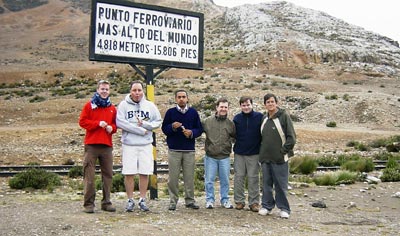
Standing at the world's highest railway line
(Arthur Jackson, 2005)
|
The course group was a fantastic group. We represented their youngest year to date with many people in their late twenties or early thirties. We really coalesced as a group and were subsequently told that we were the first class that actually came across as a class, as opposed to a gathering of like-minded people learning the same material.
One weekend we were offered a trip to the highest rail crossing in the Andes. It was for historical interest and practical medical experience. The medical history related to the fact that thousands of workers had died constructing one of the bridges due to a very dangerous type of bacterial infection called bartonellosis, which is endemic in the inter-Andean valleys, but rarely found elsewhere.
On the practical medical side, we experienced at first hand the effects of high altitude. It was incredible to start off the day with breakfast at sea level in Lima and then a few hours later to be feeling the effects of 5,000 metres of altitude. We had a pulse oximeter, a device one puts over the fingertip that gives a reading of the amount of oxygen the blood is carrying. Normal levels would be near 100 per cent. At that height, without supplemental oxygen the readings were very low. My own levels were seventy-seven per cent, which had me bluish in the lips and quite dizzy, but I was by no means the worst. One of my friends had a reading of 59 per cent and could not get off the bus to walk. An oxygen tank was available for her. Of note there were no major risks, as we stayed at that height for only about ten minutes, and then descended to a lower altitude for lunch. I remain with a more appropriate level of respect for those with low oxygen levels in hospital settings to this day.
At times it was difficult to believe that I was not on holiday. It was a real pleasure to be studying work that was really interesting and living and socialising with like-minded people in Lima. I did have the pleasure of experiencing St. Patrick’s Day - Lima style. I couldn’t persuade any of my housemates to accompany me, as we were all studying a bit more for the impending examination. I felt the obligation to go to our nearby Irish pub to have the compulsory pint or two on the evening in question. I had been avoiding it up to this, but figured that if there was a right day to go, this was it.
The place was crowded. I got talking to a many of the revellers - unfortunately none of whom claimed to be very Irish. They were mostly backpackers, many English and North American. In the whole pub, we were only three
bona fide Irish. Good live music; and an organised pint-drinking competition - won by an overweight Mexican! - that I refrained from entering.
One week of the course took place in Cuzco, the ancient Andean city of the Inca. It claims to be the oldest continually habited town in the Americas, and is so full of history, with beautiful ruins and architecture. While there, we had an intensive teaching session on Leischmania, a parasite that can cause horrendously disfiguring facial ulceration. About twenty individual cases were brought in to our classroom area one after the other, showing us the variations of the disease, emphasising the point by repetition. This method was so much more effective than reading about the topic in a book.
|

Machu Picchu
(Arthur Jackson, 2005)
|
We also did ward round at the local hospital, seeing more diseases of poverty, including malnutrition. The indigenous Andean population in the area were certainly more disadvantaged in the material sense than the
mestizo populations of the bigger cities. This was manifest in the conditions they faced, regularly requiring hospitalisation - while there we saw cases of childhood malnutrition and neonatal syphilis - conditions almost eradicated in areas of equitable health delivery.
From Cuzco most people took the opportunity to visit the ancient ‘lost’ city of Macchu Pichu. It is simply an incredible place and worth all the hyperbole. The scenery there is breathtaking, everything so remote. And the historical significance and the scale of the engineering feat are awe-inspiring. Despite the tourists, one can leave the guided tours and be soaked up in the considerable size of the city, and feel completely alone. It was also possible to climb to the top of the overlooking mountain and sit above it feeling ‘on top of the world’.
|
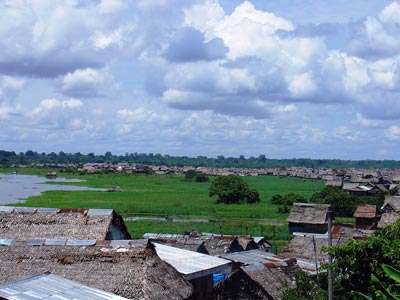
Iquitos
(Arthur Jackson, 2005)
|
Our examination came and went, as all examinations do. There was a lot of material to cover and certainly a great deal of study required. Thankfully, nearly everyone was successful, resulting in an internationally recognised Diploma in Tropical Medicine and Hygiene, and a Certificate in Clinical Tropical Medicine.
Following the exam, we spent a week in an incredible city called Iquitos. This is a fascinating place in the Amazon jungle that is near the border with Ecuador. It has the claim to fame of being the largest city in the world with no roads leading into it - to get there one has to travel by boat or aeroplane. The most remarkable things to note are the heat and humidity. They hit one like a heavy damp curtain as soon as one steps outside an air-conditioned establishment. The Peruvians claim with absolute seriousness that the climate (or humidity) makes all outsiders go crazy and that we were all likely to do things of extreme passion (murder and love were cited as examples). Neither eventuality befell me but I could see what they were referring to: there is a true sense of isolation and a feeling almost of desperation from the combination of one’s geographical coordinates and intense climate.
With our examination over this was a time to take in the medical rounds for the sheer enjoyment of it, without the worry of a looming test at the end. We saw more features of the climate influencing the variety of diseases. Wards were teeming with malaria, and many other mosquito-borne diseases. Hepatitis B is a major problem in this area and we saw many sad cases of young patients with liver cancers as a result. We were also lucky, as was the patient in question, to have the foremost world expert on snakebites to hand when we encountered a lady who had been bitten that morning by a brown snake. It was amazing to hear her history lead to a series of Sherlock Holmes-like deductions on the age, diet and potential lethality of the snake. All this was happening as the patient was awaiting the anti-venom, to be retrieved from the storage area. Apart from some transient bleeding from her mouth the patient did very well following the medication.
|
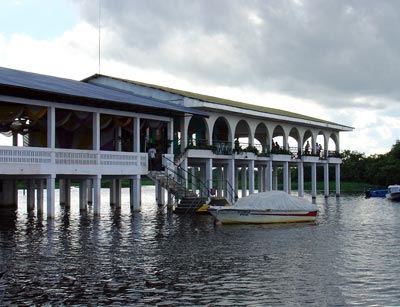
Graduation ceremony on a tributary of the Amazon
(Arthur Jackson, 2005)
|
Our graduation ceremony took place in a surreal structure in the middle of the nearby tributary of the Amazon river. It was a large, open-air structure that stood on stilts above the immense body of water. We had a lavish feast of local delicacies, including turtle,
ceviche (marinated raw fish), and guinea pig (a national speciality). It was certainly an emotional gathering (perhaps thanks to the aforementioned jungle passion) as we said goodbye to each other, not sure if we would ever meet again. A wonderful group of colleagues.
On returning to work in inner-city Dublin I was wondering if I would ever get to use my newly acquired knowledge. I did not have to wait long! First day back I had a call about a man who had been travelling in South America and now had a big rash on his back. Then a call about a splenectomised veterinarian recently returned from Pakistan and Argentina, who was now presenting with a fever and swollen glands. These were followed a couple of days later by a man in the clinic with chronic diarrhoea, HIV, and unresolving Entamoeba, Giardia and Iodamoeba in his stool, following a trip to Brazil.
Looking back on my two-month period I realised that my naive earlier preconception of an easily describable uniform South America had been wrong. In my brief stay in one country I saw such a variety of climates and biospheres, ranging from desert to alpine forests to true Amazonian jungle. The people I met fell into many ethnic groups also, having encountered jungle tribes, Andean villagers, and the most common Peruvian
mestizo. I was even made aware that there is some differentiation (dare I say ‘discrimination’) based on how European the different average Peruvians look. As visitors to the country, we were made to feel extremely welcome wherever we went, and were embraced socially by the university staff and students. A one line, or one paragraph, summary of how well we were treated would not do it justice.
The Gorgas Course in Tropical Medicine was definitely one of the highlights of my career. As training in the area of tropical medicine, and an introduction to work in resource-limited areas, it would appear to be second to none. Long may it continue.
Dr Arthur Jackson
Notes
1
Dr Arthur Jackson is a medical graduate of Trinity College,
Dublin (2001). He is currently a Fourth Year specialist
registrar in Infectious Diseases and General Medicine
with the Royal College of Physicians of Ireland. Since
July 2008, he has been based in Malawi, Africa, doing
HIV-related research in a collaborative project between
University of London (St George’s Hospital) and University
of North Carolina.
2
The course was named after Dr William
Crawford Gorgas (1854-1920), best known for his research
about the transmission of yellow fever and malaria through
mosquitoes (a study based on the insights of a Cuban doctor,
Carlos Finlay).
|






